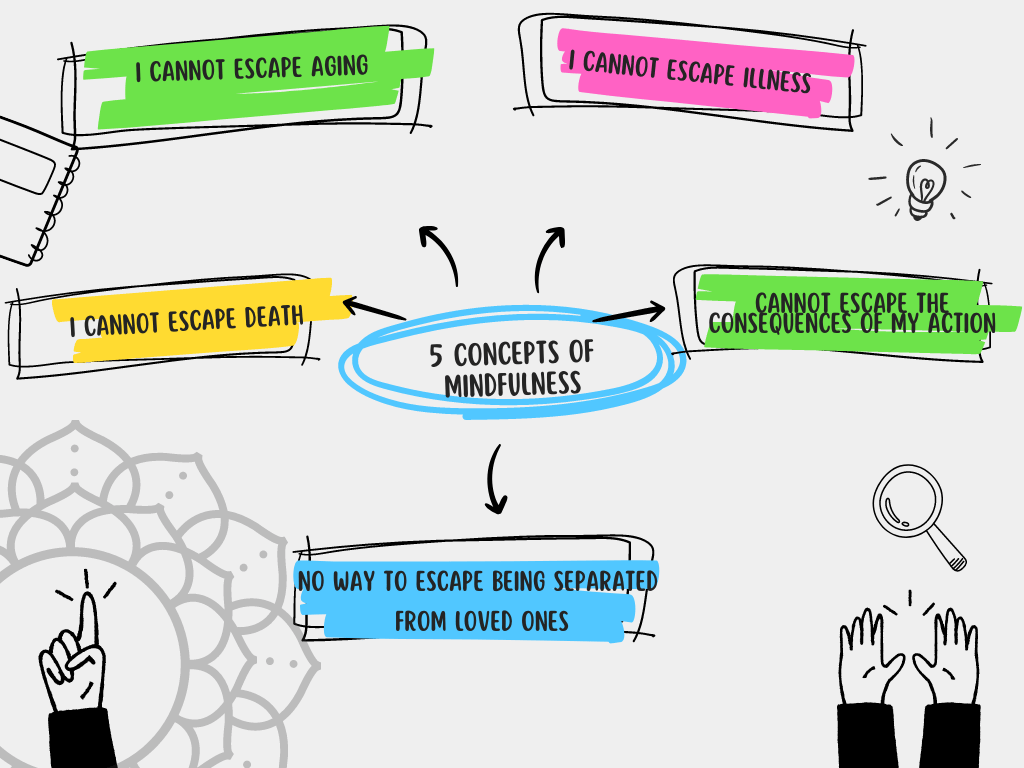Mindfulness at workplace involves cultivating a state of present-moment awareness . Now what is that , you may ask !! In simple terms its the event or practice wherein you focus your attention on tasks, interactions, and surroundings without judgment. This practice encourages individuals to fully engage in their work responsibilities, fostering a heightened sense of clarity and focus. By being present in each moment, employees can reduce stress and distractions, enhance their decision-making abilities, and improve their overall work performance.
Mindfulness empowers individuals to approach challenges and interactions with a calm and centered mindset, leading to more effective communication, better relationships, and increased job satisfaction. As a result, integrating mindfulness into the workplace not only benefits individuals’ well-being but also contributes to a more productive and harmonious work environment.

Practicing mindfulness at work can help you become more focused, present, and effective in your tasks.
Table of Contents
Steps you can take to incorporate mindfulness at workplace:
- Start Your Day Mindfully: Begin your day with a few moments of quiet reflection. Take a few deep breaths and set a positive intention for the day ahead.
- Mindful Morning Routine: Pay attention to each step of your morning routine – from brushing your teeth to getting dressed. Engage all your senses in the experience.
- Mindful Breathing: Throughout the day, take short breaks to focus on your breath. Close your eyes if possible and take a few deep breaths, inhaling and exhaling slowly.
- Single-Tasking: Instead of multitasking, dedicate your full attention to one task at a time. Complete it mindfully before moving on to the next.
- Mindful Eating: During lunch or snack breaks, eat mindfully. Pay attention to the flavors, textures, and sensations of each bite.
- Mindful Walking: If possible, take a mindful walk during breaks. Pay attention to each step and the sensations in your feet as they touch the ground.
- Mindful Listening: When interacting with colleagues, clients, or superiors, listen actively and fully. Give your full attention to the conversation.
- Desk Clearing: Before starting a task, take a moment to clear your workspace. A clutter-free environment can help reduce distractions and promote focus.
- Mindful Transition: As you move from one task to another, take a deep breath and consciously transition your focus. Let go of the previous task before diving into the new one.
- Mindful Email Checking: Instead of checking emails constantly, set specific times to check and respond to emails mindfully. Avoid letting email interruptions disrupt your workflow.
- Mindful Meetings: Approach meetings with presence. Focus on the agenda and participate actively by offering your input and listening attentively to others.
- Mindful End-of-Day Reflection: Before leaving work, take a moment to reflect on your accomplishments and express gratitude for the day.
- Mindful Breathing Before Stressful Tasks: Before tackling a challenging task or situation, take a few deep breaths to center yourself and calm your nerves.
- Mindful Posture: Pay attention to your posture while sitting or standing. Adjust your posture to feel more grounded and aligned.
- Mindful Commuting: If you commute, use the time to be present. Observe your surroundings, listen to soothing music, or practice mindful breathing.
- Mindful Moments: Whenever you find yourself feeling stressed or overwhelmed, pause for a moment and take a few deep breaths. Bring your attention back to the present.
- Mindful Gratitude: Throughout the day, take moments to express gratitude for the positive aspects of your work and the opportunities it provides.
Remember that mindfulness is a skill that develops over time with practice. Be patient with yourself , do not punish yourself for forgetting few steps – remember you are not allowed to judge – you are just the silent observer of yourself . Make an effort to integrate these practices gradually into your routine. The goal is not to be mindful all the time, but to cultivate moments of presence and awareness that can enhance your overall well-being and productivity at work.
Benefits of incorporating mindfulness into your workday
Mindfulness at work refers to the practice of being fully present, aware, and focused on your tasks, interactions, and surroundings in a work environment. It involves cultivating a state of non-judgmental awareness and intentionality, which can lead to improved well-being, productivity, and overall job satisfaction. Here are some key aspects and benefits of practicing mindfulness at work:
- Reduced Stress: Mindfulness helps manage stress by encouraging you to stay present and not get caught up in future worries or past regrets. This can lead to a more relaxed and composed approach to work-related challenges.
- Improved Focus: Mindfulness enhances your ability to concentrate on tasks without being easily distracted. As a result, you can complete tasks more efficiently and with better quality.
- Enhanced Decision-Making: When you’re mindful, you can make decisions with greater clarity and consideration. You’re less likely to react impulsively and more likely to respond thoughtfully to situations.
- Effective Communication: Mindfulness fosters better listening skills and more empathetic communication. You pay full attention to your colleagues or clients, improving the quality of your interactions.
- Creativity and Innovation: Being present allows you to think more creatively, generating new ideas and perspectives that might be overlooked when your mind is preoccupied.
- Better Time Management: Mindfulness helps you prioritize tasks and manage your time effectively. You’re more aware of how you allocate your time and can make conscious choices about where to focus your energy.
- Work-Life Balance: By staying present at work, you can prevent work-related stress from encroaching on your personal time. This supports a healthier work-life balance.
- Increased Job Satisfaction: Mindfulness encourages you to find meaning and purpose in your work. This can lead to greater job satisfaction and a sense of fulfillment.
- Resilience: Mindfulness contributes to emotional resilience. You’re better equipped to handle setbacks and challenges, bouncing back more quickly.
- Positive Work Environment: When individuals practice mindfulness, it can influence the overall work culture. A workplace that values present-moment awareness often fosters better relationships, collaboration, and a sense of community.
- Self-Awareness: Mindfulness helps you become more aware of your thoughts, emotions, and reactions. This self-awareness can guide personal and professional growth.
- Conflict Resolution: Mindfulness promotes a calmer and less reactive approach to conflicts. You’re better able to respond rather than react impulsively, leading to more effective conflict resolution.
Incorporating mindfulness at work can be done through short mindfulness exercises, meditation breaks, mindful breathing, or even integrating mindfulness into routine tasks. It’s a practice that takes time to develop but can have a profound positive impact on your well-being and productivity in the workplace.
Summary
Mindfulness at work involves cultivating a state of present-moment awareness, which helps employees reduce stress and distractions, enhance their decision-making abilities, and improve their overall work performance. This leads to better communication, better relationships, and increased job satisfaction.
Steps you can take to incorporate mindfulness into your workday include: starting your day with a few moments of quiet reflection.
Mindful gratitude can enhance your overall well-being and productivity at work. Be patient with yourself and make an effort to integrate these practices gradually into your routine.
Mindfulness at work helps manage stress by encouraging you to stay present and not get caught up in future worries or past regrets. This can lead to a more relaxed and composed approach to work-related challenges.

FAQ’s
What it means to be mindfulness?
Mindfulness is the practice of purposefully focusing your attention on the present moment without judgment, fostering awareness and acceptance of your thoughts, feelings, and surroundings.
Mindfulness originated from Buddhist meditation practices but has been adapted and integrated into various secular contexts, including psychology, wellness, and stress reduction programs. The core idea is to cultivate a heightened sense of awareness, focus, and clarity in your daily life.
What are the 5 concepts of mindfulness
I am of the nature to age – I cannot escape aging.
I am of the nature to become ill – I cannot escape illness.
I am of the nature to die – I cannot escape death.
All that is dear to me and everyone I love are of the nature to change; there is no way to escape being separated from them.
My actions are my only true belongings – I cannot escape the consequences of my action
What is mindfulness in HR?
In the context of Human Resources (HR), mindfulness refers to the application of mindfulness principles and practices to improve workplace dynamics, employee well-being, and overall organizational performance. It involves integrating mindfulness techniques into HR strategies to promote a more mindful and productive work environment.
How does mindfulness benefit the workplace?
Mindfulness offers several benefits to the workplace, contributing to improved employee well-being, productivity, and overall organizational success. Here are some ways in which mindfulness can positively impact the workplace:
Stress Reduction: Mindfulness practices help employees manage stress by promoting relaxation, reducing anxiety, and improving emotional resilience, leading to a more focused and composed workforce.
Increased Focus and Concentration: Mindfulness training enhances attention and concentration, allowing employees to stay more engaged in their tasks, make fewer errors, and complete tasks more efficiently.
Enhanced Emotional Regulation: Mindfulness helps individuals become more aware of their emotions without reacting impulsively, leading to better control of emotional responses and more thoughtful decision-making.
Improved Communication: Mindfulness fosters active listening and present-moment awareness, enhancing effective communication, reducing misunderstandings, and improving collaboration.
Better Decision-Making: Mindfulness encourages employees to approach decision-making with clarity and perspective, reducing the influence of biases and improving the quality of choices made.
Creativity and Innovation: Mindfulness techniques stimulate creative thinking and lateral problem-solving, encouraging innovative ideas and approaches to challenges.
Reduced Burnout: Mindfulness practices promote work-life balance and prevent burnout by helping employees set boundaries and manage work-related stressors more effectively.
Team Cohesion: Mindfulness can improve interpersonal relationships and teamwork by fostering empathy, respect, and a positive work environment.
Leadership Development: Mindfulness training for leaders enhances their emotional intelligence, self-awareness, and ability to lead with empathy and compassion.
Resilience to Change: Mindfulness helps employees adapt more gracefully to organizational changes and uncertainties, reducing resistance and facilitating smoother transitions.
Customer Relations: Mindful employees are more likely to provide attentive and empathetic customer service, leading to improved customer satisfaction and loyalty.
Organizational Culture: When mindfulness is integrated into the workplace, it sends a message that employee well-being and mental health are valued, contributing to a positive organizational culture.
Employee Retention and Engagement: A workplace that promotes mindfulness is likely to attract and retain employees who value well-being and personal growth, leading to higher levels of job satisfaction and engagement.
It’s important to note that implementing mindfulness in the workplace requires thoughtful planning and integration. Offering mindfulness programs, workshops, and resources, as well as fostering leadership support and a culture of openness, can contribute to the successful adoption of mindfulness practices and the realization of these benefits.
How to be more mindful at work ?
Being more mindful at work involves incorporating intentional practices into your daily routine to enhance your focus, reduce stress, and improve your overall well-being. Here are some steps you can take to cultivate mindfulness in the workplace:
Start with Intention: Begin your workday with a conscious intention to be more mindful. Set a positive tone for the day by reminding yourself to stay present, focused, and open-minded.
Mindful Breathing: Throughout the day, take short breaks to practice mindful breathing. Focus your attention on your breath, inhaling and exhaling slowly and deeply. This simple practice can help calm your mind and enhance your awareness.
Single-Tasking: Instead of multitasking, dedicate your attention fully to one task at a time. Engage in the task with your complete focus, and once it’s done, move on to the next.
Mindful Transitions: Pay attention to the transitions between tasks or activities. Take a moment to pause, breathe, and reset your focus before moving on to the next task.
Mindful Eating: If you have lunch or snacks at your workplace, eat mindfully. Pay attention to the taste, texture, and aroma of your food. Chew slowly and savor each bite.
Walking Mindfully: While walking in the office or between meetings, practice walking mindfully. Feel the sensation of each step and the contact of your feet with the ground.
Technology Breaks: Set aside specific times to check emails, messages, and notifications. Avoid constantly reacting to digital distractions; instead, allocate dedicated periods for communication.
Mindful Listening: When engaging in conversations, practice active listening. Give your full attention to the speaker, without interrupting or formulating your response in your mind.
Mindful Posture: Pay attention to your posture while sitting or standing. Sit upright with a relaxed yet alert posture, which can help improve your focus and energy.
Mindful Breathing Spaces: Designate specific points in your day for brief moments of mindful breathing. This could be before meetings, during breaks, or whenever you feel stressed.
Mindful Reflection: Take a few minutes at the end of the day to reflect on your accomplishments, challenges, and interactions. This reflection can help you learn from your experiences and set a positive tone for the next day.
Gratitude Practice: Express gratitude for the positive aspects of your work environment, colleagues, and opportunities. This can foster a more positive and appreciative mindset.
Mindful Endings: Before leaving work, take a moment to acknowledge the work you’ve completed and set an intention for the next day. This can help you mentally transition from work mode to personal time.
Remember that cultivating mindfulness is a gradual process, and consistency is key. Start with small steps and gradually incorporate more mindful practices into your daily routine. Over time, you’ll likely notice improvements in your focus, stress levels, and overall well-
